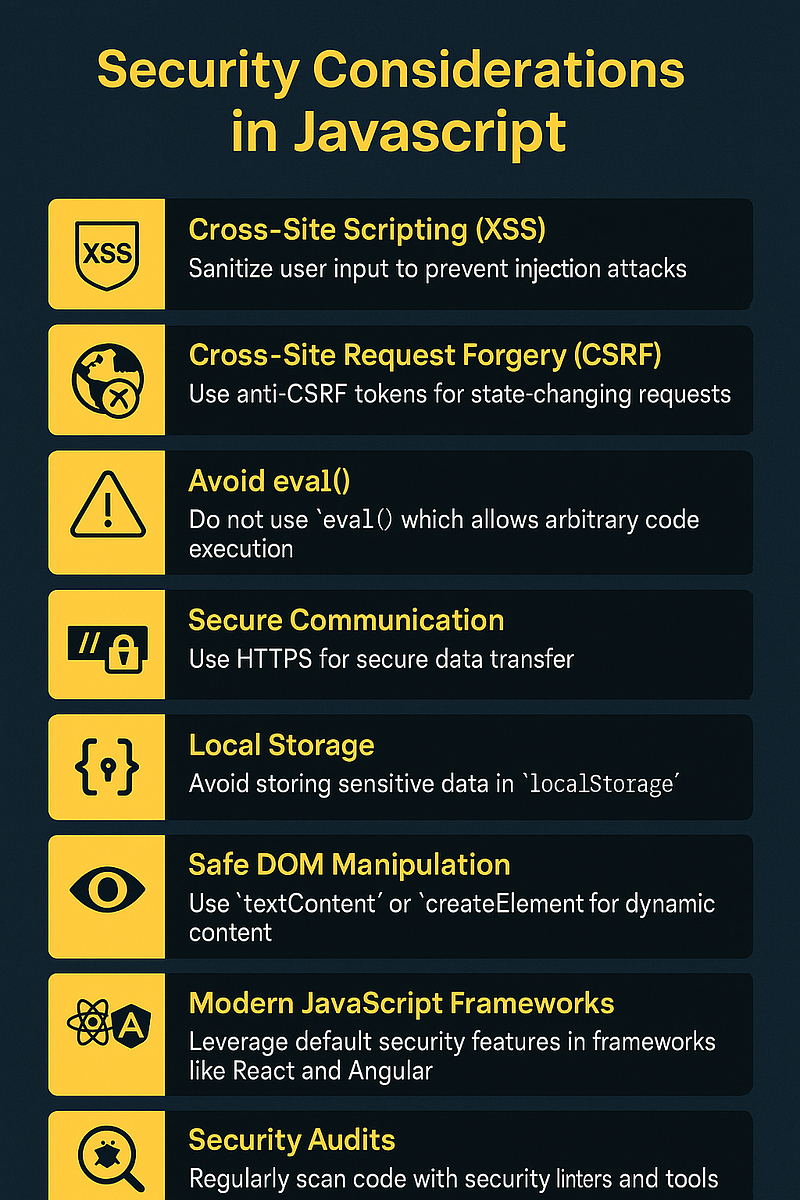JavaScript Security Best Practices – Secure Your Web App
Example of a Cross-Site Scripting (XSS) attack in JavaScript
Security Considerations in JavaScript: Protecting Your Web Applications
JavaScript is powerful, but with great power comes great responsibility. As JavaScript runs in the user's browser, it is a prime target for various attacks. Understanding and addressing common security risks is crucial for building safe and secure web applications.

1. Cross-Site Scripting (XSS)
What is XSS?
XSS allows attackers to inject malicious scripts into web pages viewed by users.
Prevention Techniques:
Use
textContentinstead ofinnerHTMLEscape user input
Use Content Security Policy (CSP)
Sanitize inputs using libraries like DOMPurify
const safeText = document.createTextNode(userInput);
element.appendChild(safeText);
2. Cross-Site Request Forgery (CSRF)
What is CSRF?
CSRF tricks a logged-in user into submitting a malicious request on another site.
Prevention Techniques:
Use anti-CSRF tokens
Implement SameSite cookie attribute
Validate HTTP Referer headers
3. Input Validation & Sanitization
Never trust user input. Improper input handling is a root cause of many security issues.
Best Practices:
Validate data on both client and server
Use whitelisting over blacklisting
Strip dangerous characters or scripts
function validateUsername(name) {
return /^[a-zA-Z0-9_]{3,20}$/.test(name);
}
4. Avoid Using eval()
The eval() function executes code from a string, making it extremely dangerous.
Alternatives:
Use
JSON.parse()for JSONUse functions or modules instead of dynamic evaluation
// Instead of:
eval("alert('Hello')");
// Use:
alert('Hello');
5. Secure APIs and AJAX Calls
JavaScript often interacts with backend servers via APIs, which must be secured.
Best Practices:
Use HTTPS for all requests
Validate tokens and credentials
Implement rate limiting and CORS policies
6. DOM-Based Vulnerabilities
Manipulating the DOM without validation can expose your app to injection and manipulation.
Tips:
Use safe DOM APIs
Avoid setting
innerHTMLwith untrusted contentSanitize URLs and data before insertion
7. Secure Local Storage Usage
Local Storage is easily accessible via browser dev tools.
Recommendations:
Don’t store sensitive data (e.g., passwords, tokens)
Use sessionStorage for short-term data
Encrypt data if needed
8. Use Modern Frameworks & Tools
Modern front-end frameworks often have built-in security features.
Suggestions:
React escapes output by default
Angular includes XSS protection
Use frameworks that support TypeScript for type safety
9. Regular Security Audits & Testing
Strategies:
Use automated tools like ESLint Security plugin, SonarQube
Conduct regular penetration testing
Monitor dependencies for vulnerabilities (e.g., with
npm audit)
Conclusion
Securing your JavaScript code is not a one-time task but an ongoing process. Stay updated with security best practices, validate all inputs, and use modern tools and frameworks to help guard against threats.
By prioritizing security at every step, you protect both your users and your brand.
Table of content
- 1. Introduction to JavaScript
- 2. JavaScript Basics
- 3. Control Flow & Loops
- 4. Functions in JavaScript
- 5. Objects & Arrays
- 6. JavaScript ES6+ Features
- 7. JavaScript DOM Manipulation
- 8. JavaScript Events & Event Listeners
- 9. JavaScript Error Handling
- 10. Asynchronous JavaScript
- 11. JavaScript Object-Oriented Programming (OOP)
- 12. JavaScript Modules & Import/Export
- 13. Working with APIs & Fetch
- 14. JavaScript Storage
- 15. JavaScript Frameworks & Libraries
- 16. Best Practices & Optimization
- 17. JavaScript Interview Questions & Practice